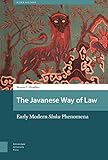The Javanese Way of Law : Early Modern Sloka Phenomena / Mason Hoadley.
Material type: TextSeries: Asian History ; 9Publisher: Amsterdam : Amsterdam University Press, [2019]Copyright date: ©2019Description: 1 online resource (276 p.)Content type:
TextSeries: Asian History ; 9Publisher: Amsterdam : Amsterdam University Press, [2019]Copyright date: ©2019Description: 1 online resource (276 p.)Content type: - 9789048541898
- 349.5982 23
- KNW192 .H63 2019
- online - DeGruyter
| Item type | Current library | Call number | URL | Status | Notes | Barcode | |
|---|---|---|---|---|---|---|---|
 eBook
eBook
|
Biblioteca "Angelicum" Pont. Univ. S.Tommaso d'Aquino Nuvola online | online - DeGruyter (Browse shelf(Opens below)) | Online access | Not for loan (Accesso limitato) | Accesso per gli utenti autorizzati / Access for authorized users | (dgr)9789048541898 |
Frontmatter -- Table of Contents -- List of Tables -- Preface -- Introduction -- Section I. Law, Sloka, and Sources -- 1. Traditional Law. Sloka in Pepakem -- 2. Sloka in Javanese Titles -- Section II. Sloka Phenomena in Vignettes -- 3. Sloka -- 4. Aksara -- 5. Sinalokan -- 6. Prakara -- 7. Vignettes and Practice -- Section III. Character, Apparent Demise, and Context -- 8. Character -- 9. Context -- Section IV. End Material -- Appendix I. The Problematic Pepakem Tjerbon -- Appendix II. Classic Sloka -- Appendix III. Titles 'Left Out' -- Appendix IV. Diverse Components -- Abbreviations -- Sources Consulted -- Index
restricted access online access with authorization star
http://purl.org/coar/access_right/c_16ec
The author's investigation of early-modern Javanese law reveals that judicial authority does not come from the contents of legal titles or juridical texts, but from legal maxims and variations thereof. A century and a half ago Simon Keyzer, a recognized scholar of Javanese law, noted that understanding of that law is dependent upon a grasp of such pithy expressions, which provide the key to the whole body of suits. (Preface, C.F. Winter, Javaansche Zamenspraken, 1858, which examines hundreds of sloka, the majority of which are directed to prevailing legal practice).Drawing upon the contents of 18th century Javanese legal texts, the present work builds upon Keyzer's and Winter's references to 'sloka-phenomena', namely sloka proper (maxims) and its derivatives sinalokan (that made of sloka), aksara here meaning legal principles, and prakara (matter, case). These are usually conveyed in vignettes illustrating their function and as a group, constitute the essence of traditional Javanese written law.
Mode of access: Internet via World Wide Web.
In English.
Description based on online resource; title from PDF title page (publisher's Web site, viewed 02. Mrz 2022)


